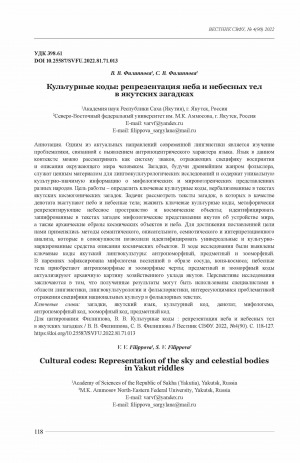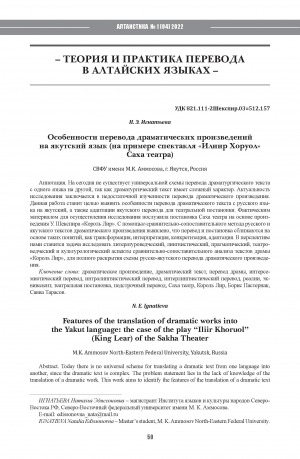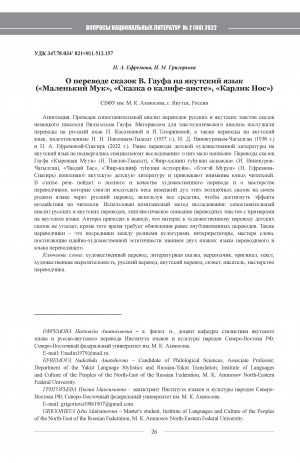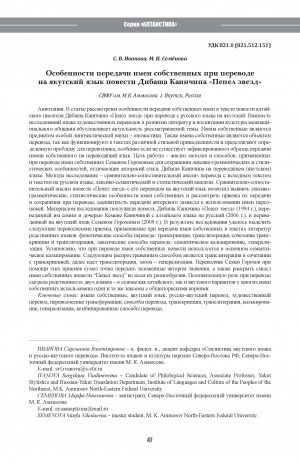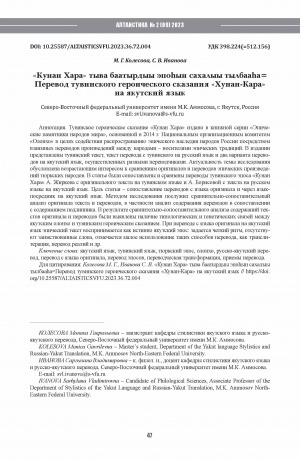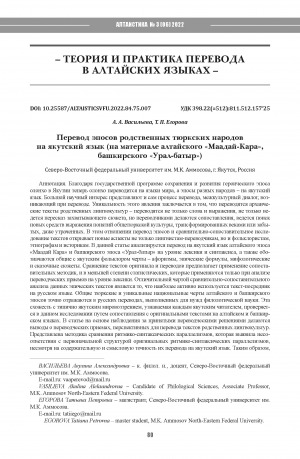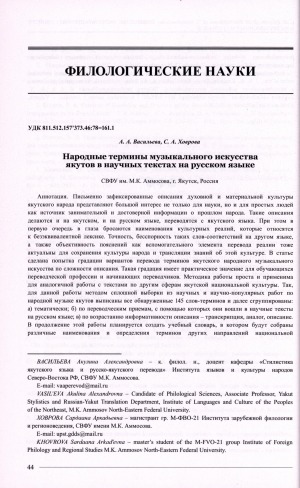
Семиотический анализ текстов родственных лингвокультур в переводоведческом ракурсе (на материале якутского перевода повести Чингиза Айтматова "Первый учитель") = Semiological analysis of linguoculturally related texts from a translation perspective (a case study of the yakut translation of Chinghiz Aitmatov’s novel "The first teacher")
Статья в журнале
Русский
811.512.154'255.2=512.167; 821.512.154-821Айтматов.03=512.167
10.25587/2782-6627-2024-3-68-80
Чингиз Айтматов; Николай Кондаков; художественное произведение; перевод; киргизская литература; лингвокультура; семиосфера; ситуативная реалия; культурный код; лингвокультурема; Chinghiz Aitmatov; Nikolai Kondakov; literary text; translation; Kyrgyz literature; linguoculture; semiosphere; contextual culture-specific element; culture code; linguocultureme
Based on the semiotic models of Juri Lotman, this article regards a literary text as an interaction of semiospheres and its translation as a conversion from one cultural code to another. The article gives key takeaways from the conducted analysis of the three texts of Chinghiz Aitmatov’s novel “The First Teacher” - the original in the Kyrgyz language, the author’s translation into the Russian language, and the translation into Yakut language. Several semiospheres are unraveled in the two author’s texts which both are the originals for the Yakut translation - the Kyrgyz semiosphere K, the Muslim semiosphere M, the Soviet semiosphere S (with three periods - S60, S20, and S50), the universal (common to all mankind) semiosphere Cho, and the Russian semiosphere RO. For the Yakut translator Nikolai Kondakov, the original text is the author’s translation into the Russian language, which, compared to the Kyrgyz text, contains more of the Soviet semiosphere S and has the Russian semiosphere RO familiar to all linguocultures of the people of the USSR. The article provides examples of translation into the Yakut language contextual culture-specific elements and linguoculturemes of the Kyrgyz semiosphere K, as well as idioms of the Russian semiosphere RO. The analysis concludes that the Yakut translation didn’t relay the author’s and the Kyrgyz linguoculture’s specific meaning to the full extent. Instead, the translation is transformed into a text of the Yakut semiosphere. Several reasons for this transformation are denoted - subtle differences in the expression of common Turkic concepts in related linguocultures and the personal skill of the Soviet journalist-turned-translator who tries to loan translate not only Russian idioms but also the syntax of many sentences. It is concluded that it is important to conduct a pre-translation analysis of the original with a careful review of all implicit and explicit linguocultural aspects of the text. This allows the correct translation strategy of a literary text from a related culture.
Попова, А. Н. Семиотический анализ текстов родственных лингвокультур в переводоведческом ракурсе (на материале якутского перевода повести Чингиза Айтматова "Первый учитель") / А. Н. Попова, А. А. Васильева ; Литературный институт им. А. М. Горького, Северо-Восточный федеральныйуниверситет им. М. К. Аммосова // Вестник Северо-Восточного федерального университета им. М. К. Аммосова. Серия "Алтаистика". - 2024, N 3 (14). - C. 68-80. - DOI: 10.25587/2782-6627-2024-3-68-80
DOI: 10.25587/2782-6627-2024-3-68-80
- Языкознание. Филология. Художественная литература > Языкознание и языки. Лингвистика,
- Языкознание. Филология. Художественная литература > Литература. Литературоведение,
- НАУКА ЯКУТИИ > ЯЗЫКОЗНАНИЕ. ФИЛОЛОГИЯ. ЛИТЕРАТУРОВЕДЕНИЕ. ХУДОЖЕСТВЕННАЯ ЛИТЕРАТУРА > Языкознание и языки. Лингвистика,
- НАУКА ЯКУТИИ > ЯЗЫКОЗНАНИЕ. ФИЛОЛОГИЯ. ЛИТЕРАТУРОВЕДЕНИЕ. ХУДОЖЕСТВЕННАЯ ЛИТЕРАТУРА > Литература. Литературоведение.
Войдите в систему, чтобы открыть документ
